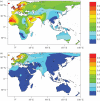Evolution of lactase persistence: an example of human niche construction
- PMID: 21320900
- PMCID: PMC3048992
- DOI: 10.1098/rstb.2010.0268
Evolution of lactase persistence: an example of human niche construction
Abstract
Niche construction is the process by which organisms construct important components of their local environment in ways that introduce novel selection pressures. Lactase persistence is one of the clearest examples of niche construction in humans. Lactase is the enzyme responsible for the digestion of the milk sugar lactose and its production decreases after the weaning phase in most mammals, including most humans. Some humans, however, continue to produce lactase throughout adulthood, a trait known as lactase persistence. In European populations, a single mutation (-13910*T) explains the distribution of the phenotype, whereas several mutations are associated with it in Africa and the Middle East. Current estimates for the age of lactase persistence-associated alleles bracket those for the origins of animal domestication and the culturally transmitted practice of dairying. We report new data on the distribution of -13910*T and summarize genetic studies on the diversity of lactase persistence worldwide. We review relevant archaeological data and describe three simulation studies that have shed light on the evolution of this trait in Europe. These studies illustrate how genetic and archaeological information can be integrated to bring new insights to the origins and spread of lactase persistence. Finally, we discuss possible improvements to these models.
Figures




References
-
- Shennan S. 2011. Property and wealth inequality as cultural niche construction. Phil. Trans. R. Soc. B 366, 918–92610.1098/rstb.2010.0309 (doi:10.1098/rstb.2010.0309) - DOI - DOI - PMC - PubMed
-
- Gintis H. 2011. Gene–culture coevolution and the nature of human sociality. Phil. Trans. R. Soc. B 366, 878–88810.1098/rstb.2010.0310 (doi:10.1098/rstb.2010.0310) - DOI - DOI - PMC - PubMed
-
- Smith B. D. 2011. General patterns of niche construction and the management of ‘wild’ plant and animal resources by small-scale pre-industrial societies. Phil. Trans. R. Soc. B 366, 836–84810.1098/rstb.2010.0253 (doi:10.1098/rstb.2010.0253) - DOI - DOI - PMC - PubMed
-
- Laland K. N., Odling-Smee J., Feldman M. W. 2000. Niche construction, biological evolution, and cultural change. Behav. Brain Sci. 23, 131–146 (Discussion 46–75).10.1017/S0140525X00002417 (doi:10.1017/S0140525X00002417) - DOI - DOI - PubMed
-
- Laland K. N., Olding-Smee F. J., Feldman M. W. 1996. On the evolutionary consequences of niche construction. J. Evol. Biol. 9, 293–31610.1046/j.1420-9101.1996.9030293.x (doi:10.1046/j.1420-9101.1996.9030293.x) - DOI - DOI
Publication types
MeSH terms
Substances
LinkOut - more resources
Full Text Sources
